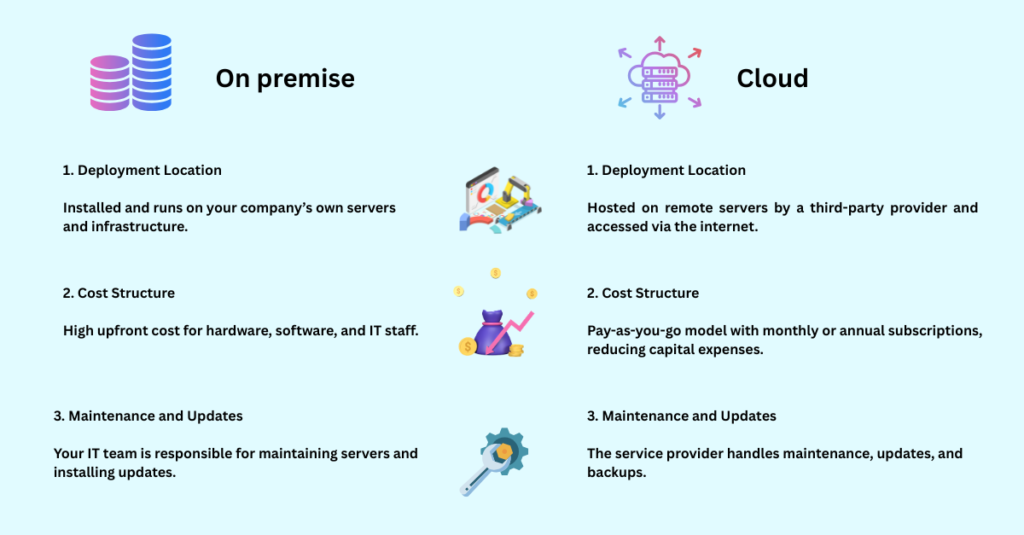Introduction: On-Premises vs Cloud EHS Software-Key Differences and Decision Guide
Environmental, Health, and Safety (EHS) software is essential for businesses focused on workplace safety and regulatory compliance. As organizations go digital, a key decision arises: should you choose an on-premises EHS solution or a cloud-based platform?
This guide compares both deployment models, helping you make the best choice for your organization’s unique operational, security, and scalability needs.
On-premises EHS software is installed and hosted on a company’s internal servers and hardware. This setup provides the company with complete control over the system, including its security protocols, customization options, and data storage. In contrast, cloud-based EHS solutions offer greater flexibility, easier updates, and remote accessibility making them particularly appealing to organizations looking for agility and lower maintenance responsibilities.
This comparison explores the core differences between On premise vs Cloud EHS software, helping organizations make informed decisions aligned with their strategic goals and operational needs.
On premises vs cloud key difference:

| Aspect | On-Premises EHS | Cloud-Based EHS |
|---|---|---|
| Deployment | Local servers | Cloud servers |
| Accessibility | Limited to internal network | Anywhere with internet |
| Customization | Highly customizable | Limited, vendor-dependent |
| Cost Structure | High upfront + maintenance | Subscription-based (lower upfront) |
| IT Support | Internal IT team required | Managed by vendor |
| Security | Full control | Managed by provider |
| Scalability | Hardware upgrade needed | Easily scalable |
| Integration | Easy with internal systems | API-dependent |
| Compliance Readiness | Full control over audit data | Built-in tools and reporting |
| Deployment Time | Weeks to months | Quick, within days |
On-Premise vs EHS Software: Making the Smart Choice for Your Organization:
a) On-Premises EHS Software:
- Local Installation
- The software is installed directly on the organization’s internal servers or computers.
- The company is responsible for maintaining the hardware and software environment.
- Data Security and Control
- The organization retains complete control over its data, with no third-party access.
- Ideal for industries with strict data privacy requirements or regulatory compliance needs.
- Customization
- More flexibility for customization based on the company’s specific EHS workflows and processes.
- IT teams can modify source code or integrate with legacy systems as needed.
- Upfront Capital Investment
- Requires significant initial costs for software licensing, infrastructure, and implementation.
- May be more cost-effective over the long term for large enterprises.
- IT Support and Maintenance
- Internal IT teams are responsible for system maintenance, updates, backups, and security.
- Requires skilled IT personnel and ongoing support costs.
- Compliance and Audit Readiness
- Helps organizations manage incident reports, audits, training, and compliance tracking.
- On-premises solutions allow for tighter control over audit trails and recordkeeping.
- Integration Capabilities
- Easier to integrate with internal enterprise systems like ERP, HRMS, or MES.
- May require custom development for integration with third-party software.
- Longer Deployment Time
- Deployment can take weeks or months, depending on the complexity and level of customization required.
- Scalability Challenges
- Scaling requires additional hardware and IT resources.
- Less flexible compared to cloud solutions when expanding across locations or regions.
b) Cloud-Based EHS Software
- Accessibility and Mobility
- Anywhere, Anytime Access: Users can access the system from any device with an internet connection, allowing for real-time updates and remote work.
- Mobile Capabilities: Field workers can input data on-site using mobile apps, improving accuracy and efficiency.
- Real-Time Data and Reporting
- Instant Updates: Real-time data entry and syncing mean decision-makers have access to the latest information.
- Dashboards and Analytics: Interactive dashboards help track compliance, incidents, and performance indicators in real-time.
- Scalability
- Grows with Your Business: Cloud solutions can easily scale as your organization changes.
- Modular Features: Add or remove modules (e.g., incident management, audits, permit to work) as needed.
- Lower IT Costs
- No On-Site Infrastructure: No need to invest in or maintain servers and hardware.
- Automatic Updates: Cloud vendors handle maintenance, upgrades, and security patches.
- Enhanced Data Security and Backup
- Vendor-Managed Security: Cloud providers invest heavily in cybersecurity measures.
- Automatic Backups: Frequent backups protect against data loss.
- Compliance and Audit Readiness
- Built-In Regulatory Tracking: Many systems include tools to help stay up-to-date with regulations.
- Easy Document Retrieval: Quickly generate reports or access historical data for audits or inspections.
Conclusion:
The choice between On premise and Cloud EHS solutions depends on an organization’s specific needs, resources, and long-term goals.
Cloud EHS solutions are generally best for businesses prioritizing cost-efficiency, scalability, and remote accessibility, while on-premise is more suitable for those needing full control and customized environments. The best option ultimately depends on a careful evaluation of business priorities, security needs, and available resources.







